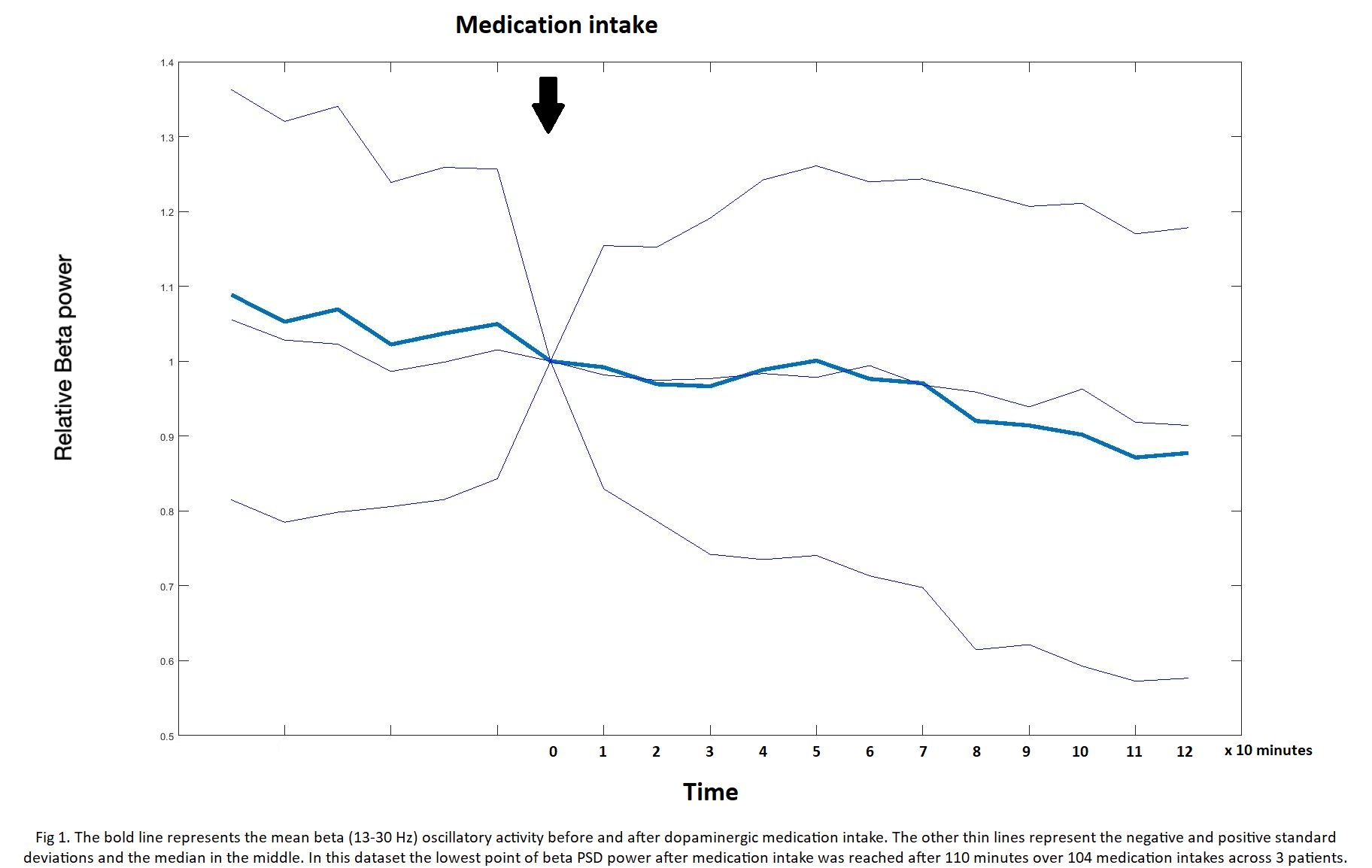Category: Parkinson's Disease: Neurophysiology
Objective: To study the relationship between oscillatory beta activity in the subthalamic nucleus (STN) and the intake of dopaminergic medication in a group of Parkinson’s disease (PD) patients treated with Deep Brain Stimulation (DBS).
Background: Bradykinesia and rigidity have been associated with the Power Spectral Density (PSD) of beta (± 13-30 Hz) oscillations in the contralateral STN. This beta PSD power can be used as a “physiomarker” for adaptive STN DBS in order to adjust the stimulation amplitude to the clinical state of the patients. To date, it is not known to which extent fluctuations in beta power are related to the intake of dopaminergic medication in patients with chronically implanted sensing-enabled DBS systems.
Method: Chronic Local Field Potential (LFP) recordings from the STN were studied in 3 patients (1 Female, age range 62-69) 9-10 (range: 6-13) weeks after DBS surgery with an average stimulation amplitude of 1.4 mA (range 0.8-1.8). Mean PD disease duration was 12 years (range 4-18). For each hemisphere, mean PSD values around the patient’s individual beta peak frequency and adjacent frequency bins (+/- 2.5 Hz) were obtained for 18 10-min time windows per medication intake for several days. Medication schedules were collected from medical files and verified with the patients. All beta PSD values were normalized to the beta PSD power on moment of medication intake. To study the change in beta PSD power after medication intake, the PSD power at the moment of intake was compared with the PSD power 110 minutes after medication intake.
Results: A total of 104 medication intakes were studied. The average beta peak was 19 Hz (range 13-23). The overall change of beta power from medication intake to 110 minutes later (Fig. 1) was -18.1% (SD 57.2; t-test p<0.0001). Overall variance of beta LFP power was 0.33% with a coefficient of variance of 0.70, indicating low variance.
Conclusion: We found that STN beta power decreases after levodopa intake. Beta powor variance of the data was low, indicating a relatively consistent effect of the beta power decrease after medication intake. This finding is of relevance for the application of adaptive STN DBS strategies, and will need to be replicated in a larger study with a longer follow-up period.
To cite this abstract in AMA style:
M. de Neeling, M. Stam, B. van Wijk, J. Anso, R. Raike, P. Schuurman, R. de Bie, A. Buijink, M. Beudel. Beta LFP Power Change After Levodopa Intake in Parkinson’s Disease Patients with Chronic Sensing-Enabled DBS Systems [abstract]. Mov Disord. 2023; 38 (suppl 1). https://www.mdsabstracts.org/abstract/beta-lfp-power-change-after-levodopa-intake-in-parkinsons-disease-patients-with-chronic-sensing-enabled-dbs-systems/. Accessed April 3, 2025.« Back to 2023 International Congress
MDS Abstracts - https://www.mdsabstracts.org/abstract/beta-lfp-power-change-after-levodopa-intake-in-parkinsons-disease-patients-with-chronic-sensing-enabled-dbs-systems/

